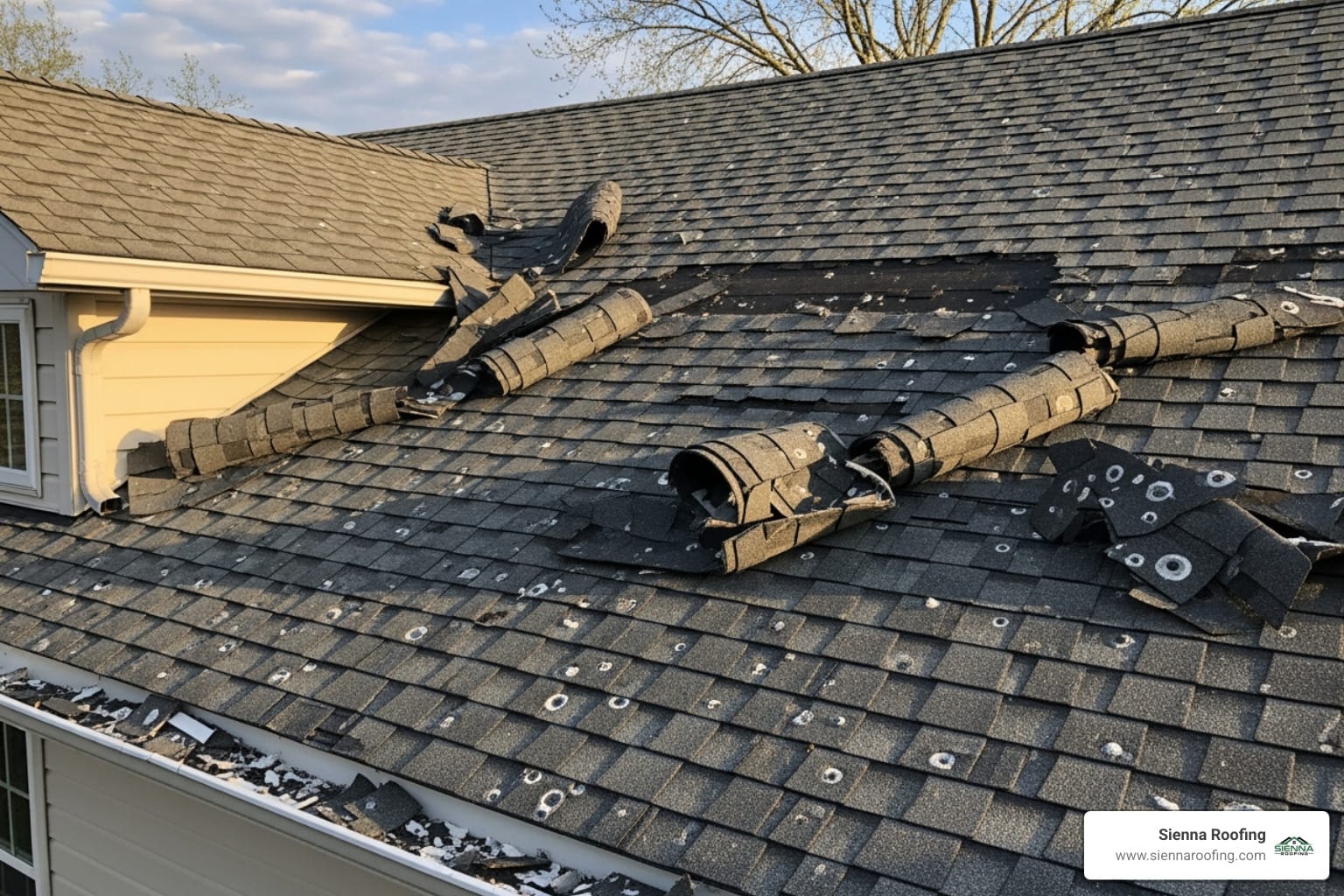Why Recognizing Storm Damage Early Can Save You Thousands
Hail and wind damage to roof systems affects thousands of Texas homeowners every year, often causing costly problems that worsen over time if left unaddressed. In 2022 alone, there were over 4,400 severe hail reports across the United States, with State Farm reporting a $1 billion increase in hail claim costs due to the increased frequency of storms.
Quick Signs of Roof Storm Damage:
- Hail damage: Dark spots on shingles, missing granules, dents on gutters and vents
- Wind damage: Missing or curled shingles, loose flashing, exposed underlayment
- Collateral indicators: Dented siding, damaged screens, granules in gutters
The challenge is that storm damage isn’t always obvious from the ground. Even golf ball-sized hail can leave nearly undetectable signs that compromise your roof’s integrity. Wind damage can be equally subtle, weakening shingle seals and creating entry points for water without immediately causing leaks.
For Sugar Land homeowners, protecting your investment starts with knowing what to look for after severe weather strikes. A professional roofing inspection can identify hidden damage before it becomes a major repair.
I’m Andre Castro, CEO of Sienna Roofing & Solar, and I’ve spent over five years helping homeowners throughout the Houston Metro area identify and repair hail and wind damage to roof systems. My hands-on experience managing storm damage claims has shown me that early detection is key to preventing costly repairs and maximizing insurance coverage.
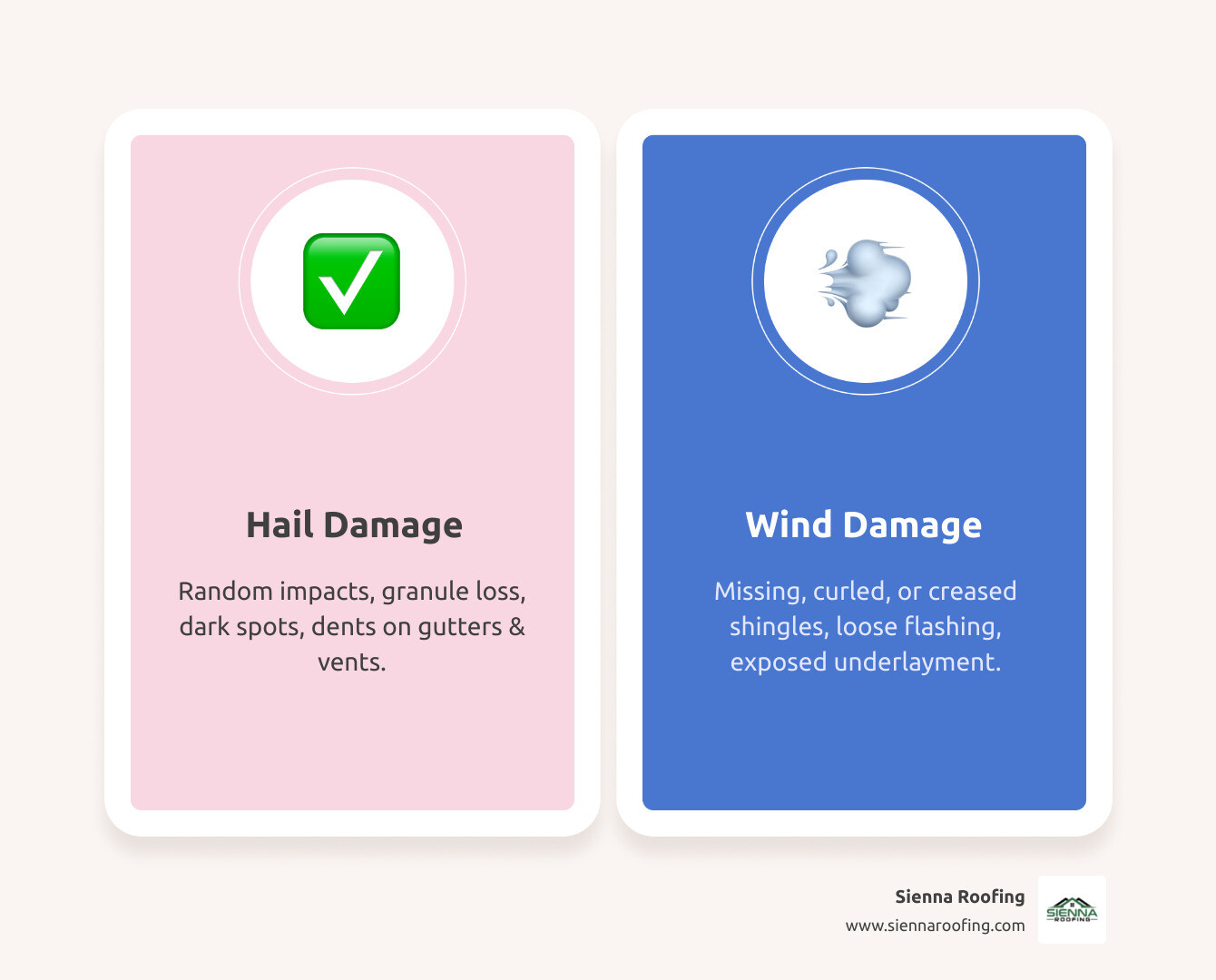
Quick look at hail and wind damage to roof:
- how to repair roof shingles
- hail damage repair cost
- how to tell if roof needs repair from hail damage
How to Spot Hail Damage on Your Roof
When Texas weather releasees its fury, your roof bears the brunt of nature’s assault. Hail and wind damage to roof systems can be deceptive – what looks minor from the ground might signal serious problems that’ll cost you thousands down the road.
The size and velocity of hailstones determine how much punishment your roof takes. Even one-inch hail can cause significant damage when driven by strong winds, while stones measuring 1.75 inches or larger can brutalize your shingles. The telltale sign that separates hail damage from normal aging? Random damage patterns scattered across your roof surface, not the uniform wear you’d see from time and weather.
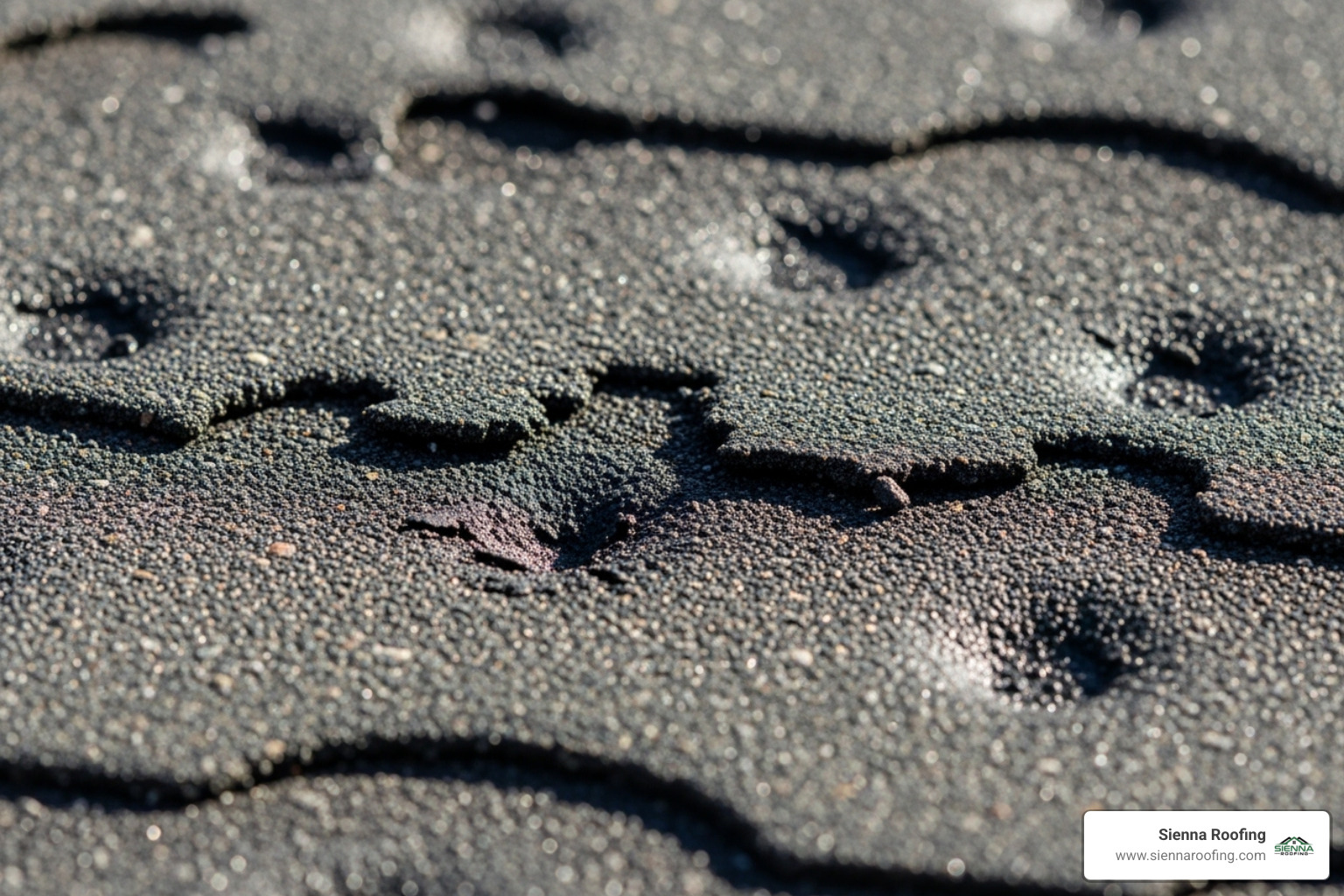
Understanding what to look for can mean the difference between a covered insurance claim and paying out of pocket for repairs. Let’s break down the specific signs based on your roofing material.
Signs of Hail Damage on Asphalt Shingles
Asphalt shingles take a beating during hailstorms, and the damage isn’t always obvious from your driveway. Granule loss is often the first clue – those protective mineral granules that give your shingles their color and UV protection get knocked loose by hail impacts. You’ll notice dark spots or “bruises” where granules have been stripped away, exposing the black asphalt underneath.
These bruised areas feel soft or spongy when stepped on, much like a bruise on fruit. In severe cases, hail can shatter through to the exposed fiberglass mat beneath, creating a direct pathway for water infiltration. Cracked or dented shingles might not be visible from ground level, but they compromise your roof’s ability to shed water effectively.
After a storm, check your gutters and downspouts for an unusual amount of granules – it’s like finding paint chips after a car accident. For a deeper dive into how hail affects this common roofing material, read more about hail damage to asphalt shingles.
Signs of Hail Damage on Metal, Tile, and Wood Shake Roofs
Metal roofs might seem invincible, but large hail leaves its mark through dents on metal panels and scratches on metal finish. Those scratches aren’t just cosmetic – they expose bare metal to moisture, creating potential for corrosion that can shorten your roof’s lifespan significantly.
Clay and concrete tiles show their battle scars differently. Cracked or chipped clay tiles are brittle by nature, so hail impacts can cause them to crack, chip, or shatter completely. These breaks become direct highways for water to reach your home’s interior.
Wood shake roofs display split or dented wood shakes along the grain lines where hail struck. You might also notice discoloration on wood where impacts damaged the wood fibers. Unlike other materials, wood damage can lead to rot and warping if moisture gets trapped in these impact zones.
The key is recognizing that even minor-looking damage can escalate quickly. What starts as a small dent or scratch can become a major leak during the next heavy rain.
How to Identify Wind Damage on Your Roof
While hail pounds your roof from above, wind attacks from every angle, creating a completely different type of destruction. Hail and wind damage to roof systems often occur together during severe storms, but wind damage has its own telltale signs that every homeowner should recognize.
Wind doesn’t just push against your roof—it creates complex pressure zones that can be surprisingly destructive. When winds exceed 40 miles per hour, they generate powerful suction forces on the leeward side and corners of your roof. These pulling pressures are what cause shingles to lift, tear, and sometimes disappear entirely.
The key difference between wind and hail damage is the pattern. While hail creates random impact marks across your roof, wind damage follows directional patterns. You’ll typically see the most severe damage on the side of your home that faced the prevailing winds during the storm. This directional damage often weakens the self-seal strips that keep shingles in place, making your roof vulnerable to future storms.
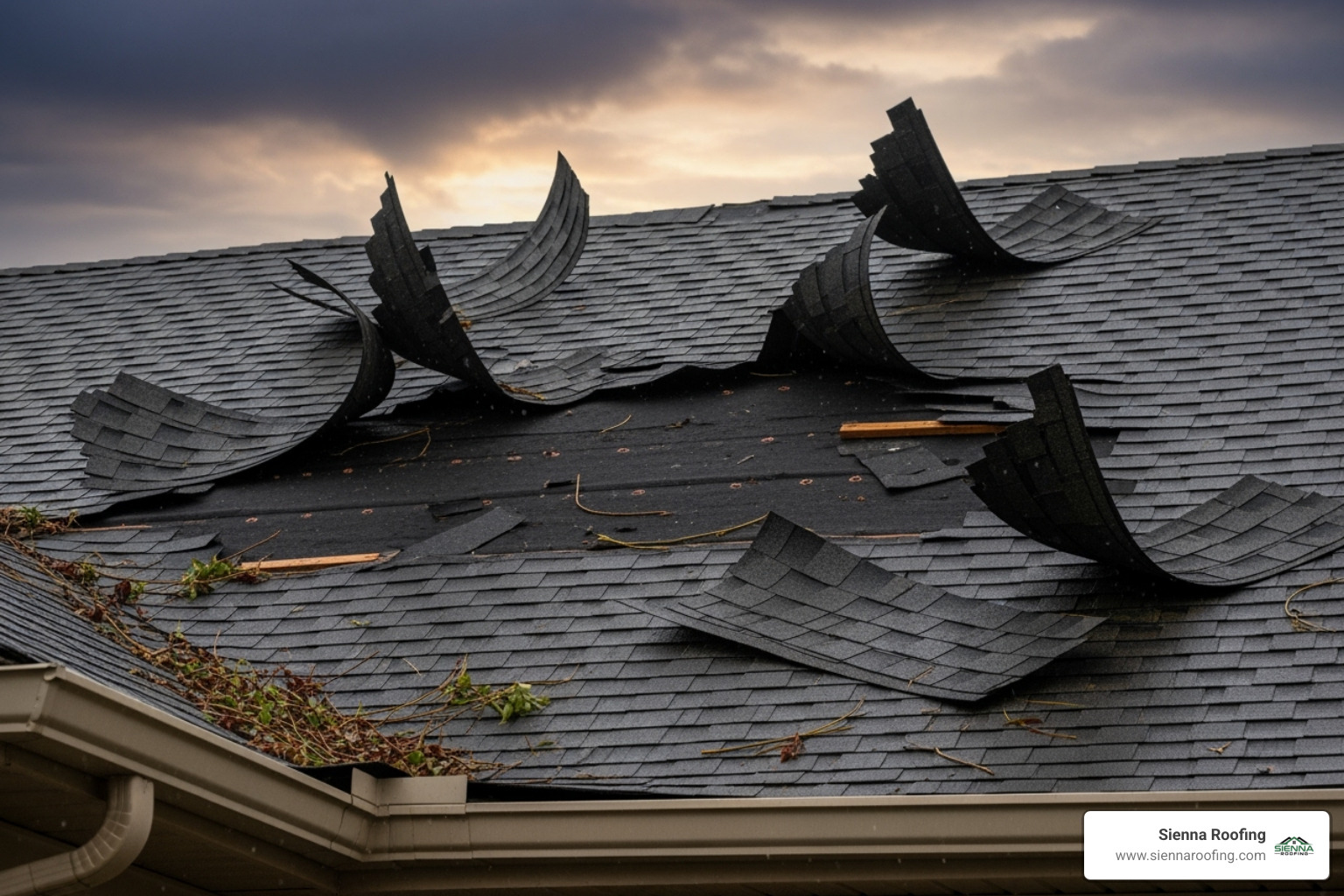
Missing, Creased, or Curled Shingles
The most obvious signs of wind damage involve your shingles themselves. Lifted shingle edges are often the first casualty of high winds. When wind gets underneath these edges, it breaks the adhesive seals and exposes your underlayment to rain and UV damage.
Sometimes shingles don’t blow off completely but get bent back by the wind, creating horizontal lines or creases across their surface. These creases might look minor, but they indicate that the shingle’s structural integrity has been compromised. Over time, these weakened areas become failure points where water can penetrate.
In severe cases, you’ll find missing shingles entirely. Large sections might be completely gone, leaving your exposed underlayment vulnerable to the elements. This black or gray material you see isn’t designed for long-term weather exposure. If left uncovered, it can deteriorate within weeks, leading to serious leaks.
When wind damage affects your shingles, quick action is essential to prevent water intrusion. For detailed guidance on addressing these issues, check out Learn how to repair roof shingles.
Damage to Flashing, Vents, and Gutters
Wind doesn’t stop at shingles—it targets every vulnerable component on your roof. Loose or bent flashing around chimneys, skylights, and roof valleys creates direct water entry points. These metal strips are your roof’s first line of defense against leaks, so any wind damage here needs immediate attention.
Damaged roof vents are another common casualty. These plastic or metal fixtures can be cracked, bent, or completely dislodged by strong winds. A damaged vent not only creates a leak risk but also compromises your attic’s ventilation system.
Your gutters tell their own story after a windstorm. Dented or detached gutters might be pulled away from the fascia board or show significant sagging. When gutters can’t function properly, water backs up and can damage your roof, siding, and foundation.
Don’t overlook what’s inside your downspouts either. After a severe windstorm, you’ll often find debris in downspouts—including shingle granules, leaves, and small branches. This debris accumulation is actually a good indicator of how much wind activity your roof experienced during the storm.
Your Guide to Assessing Hail and Wind Damage to Roof After a Storm
After a severe weather event, we understand the immediate concern you might feel about your home. The good news is, you can perform a preliminary assessment safely from the ground. Your safety is paramount. Do not climb onto a wet or damaged roof!
Step 1: Perform a Safe Ground-Level Inspection
Before calling in the pros, take a moment to look for obvious signs of damage from the safety of your yard. Even golf ball-sized hail can leave subtle signs that you might miss if you’re not looking closely. Collateral damage on other parts of your property can be a strong indicator of roof damage.
- Check Gutters for Dents: Look closely at your gutters and downspouts. Hail can leave distinct dents. If the hail was wind-driven, you might even see “innies” (dents from the outside) and “outies” (dents from the inside) on the front of the gutters, depending on the hail’s direction.
- Inspect Downspouts for Granules: An excessive amount of shingle granules in your downspouts or at the base of your downspout indicates that the protective layer of your asphalt shingles has been impacted by hail.
- Look for Damage on Siding and Window Screens: Hail can punch holes in vinyl siding or tear window screens. If you see this type of damage, it’s a strong sign that your roof likely suffered similar impacts.
- Check AC Units and Mailboxes for Dents: Metal objects around your property, like air conditioning units, mailboxes, and even outdoor furniture, can show dents and dings from hail. These are excellent collateral indicators that your roof was also in the hailstones’ path.
Step 2: Document Everything for Your Records
If you find any signs of potential damage, documentation is your best friend when dealing with insurance claims. The more evidence you have, the smoother the process will be.
- Take Photos and Videos: Use your smartphone to take clear, well-lit photos and videos of all suspected damage. Get close-ups of specific impacts and wider shots that show the overall affected area.
- Note the Date and Time of the Storm: This is crucial for insurance claims, as most policies have a timeframe for filing after the date of loss.
- Keep a Log of All Visible Damage: Write down everything you observe, including the location, type of damage, and approximate size or extent. This detailed log will be invaluable.
- Gather local weather reports confirming hail or high winds in your area. This validates your claim.
For further guidance on handling the aftermath of a storm, we’ve prepared a comprehensive guide on How to handle roof storm damage repair.
Step 3: Understand the Long-Term Risks of Minor Damage
It’s tempting to ignore minor damage, especially if there are no immediate leaks. However, this can be a costly mistake. Even seemingly small issues can lead to significant problems down the line.
- Premature Roof Aging: Granule loss from hail accelerates the aging process of asphalt shingles. Without their protective layer, shingles degrade faster, reducing your roof’s overall lifespan.
- UV Degradation from Granule Loss: The exposed asphalt on shingles, once protected by granules, becomes vulnerable to the sun’s harsh UV rays. This causes the asphalt to dry out, become brittle, and crack prematurely.
- Water Intrusion Over Time: Minor cracks, lifted seals, or compromised shingles create pathways for water to seep into your roofing system. This might not cause an immediate leak into your home, but water can slowly penetrate the underlayment and decking.
- Compromised Structural Integrity: Persistent water intrusion can lead to wood rot in your roof deck and rafters, weakening the overall structural integrity of your roof.
- Potential for Mold Growth: Moisture trapped within the roof system or attic creates an ideal environment for mold and mildew to thrive. This can lead to unhealthy indoor air quality and further damage to your home’s structure.
Ignoring roof damage, even minor, can lead to much more expensive repairs in the future, including leaks, ice dams (in colder climates), mold damage, electrical issues, and rotting wood.
Navigating the Roof Insurance Claim Process
After finding hail and wind damage to roof systems on your property, filing an insurance claim becomes the next crucial step. I know this process can feel overwhelming, especially when you’re already dealing with storm damage. But understanding how it works can make all the difference in getting the coverage you deserve.
The financial stakes are significant. The average hail damage claim has reached $9,000 over the past decade, according to CoreLogic. With 3,762 major hailstorms reported in 2021 alone, these weather events are becoming increasingly common, making it essential to understand your coverage before you need it.
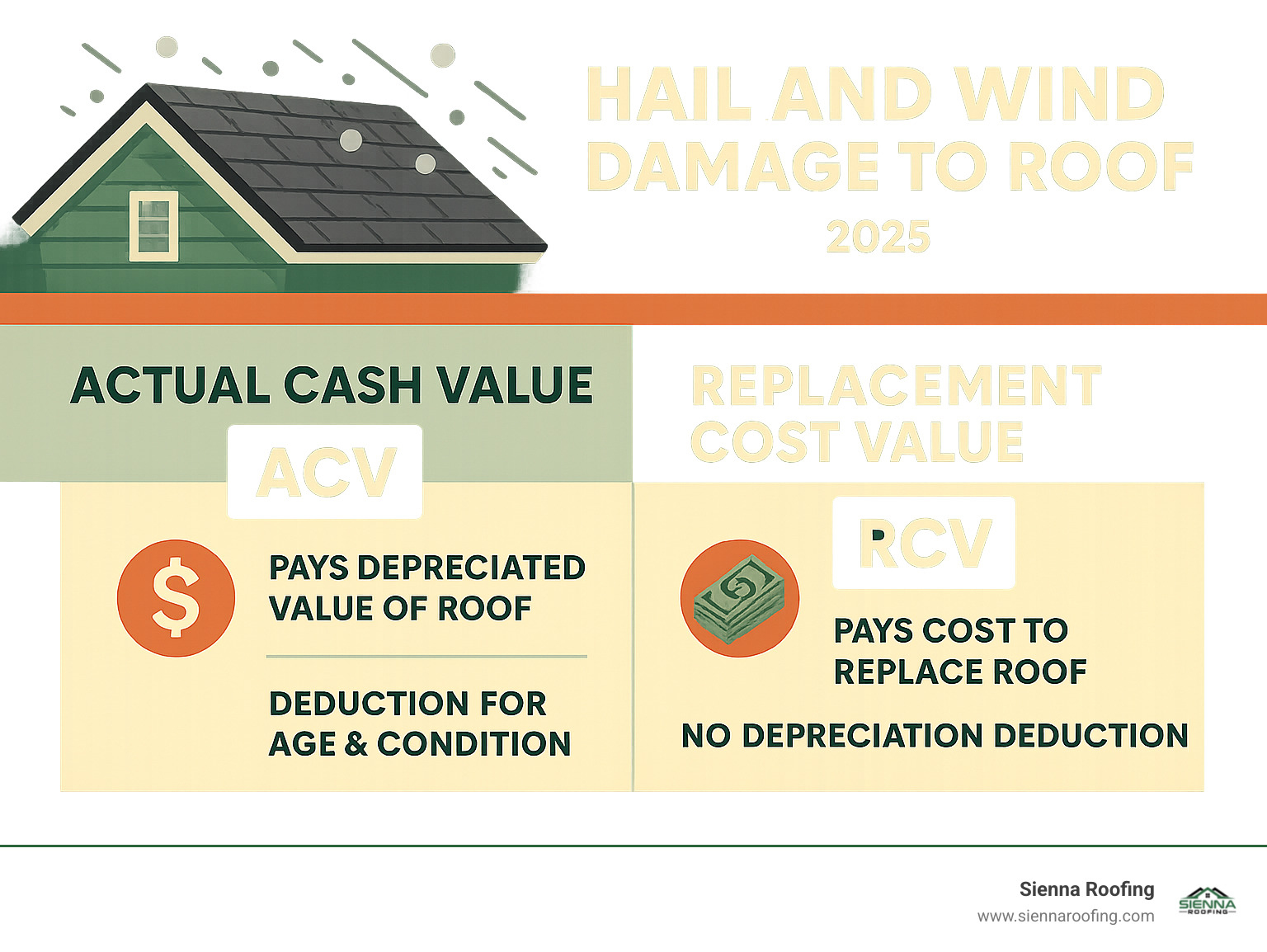
Understanding Your Homeowner’s Policy
Before you call your insurance company, take a moment to review your policy. Think of it as your roadmap through the claims process. Every policy is different, and knowing yours inside and out will help you steer what comes next.
Deductibles are your first out-of-pocket expense. Most policies have a standard deductible, but if you live in areas prone to severe weather like Houston, you might have a separate, higher deductible specifically for wind and hail damage. This can sometimes be a percentage of your home’s value rather than a flat dollar amount.
Coverage limits tell you the maximum your policy will pay for roof damage. Make sure you understand this number, as it affects how much protection you actually have.
The most important distinction to understand is between Actual Cash Value (ACV) and Replacement Cost Value (RCV) policies. ACV policies pay the depreciated value of your roof, meaning the older your roof, the less money you’ll receive. This often leaves homeowners with significant out-of-pocket expenses. RCV policies, on the other hand, pay to replace your roof with new materials of similar quality, without deducting for depreciation. While you might receive an initial ACV payment, the remaining “recoverable depreciation” gets paid once repairs are completed.
Exclusions for cosmetic damage have become more common in recent years. Some insurers now exclude damage that doesn’t affect your roof’s function or lifespan. This is where having a professional assessment becomes crucial – they can demonstrate how seemingly cosmetic damage actually compromises your roof’s protection.
If any of this feels confusing, don’t hesitate to call your insurance agent for clarification. For more detailed guidance on this process, check out our comprehensive resource on roofing insurance claims.
Key Steps for Filing a Successful Claim
Once you understand your coverage, here’s how to move forward with confidence.
Contact your insurer promptly after finding damage. Most companies require claims to be filed within one year of the storm date, but the sooner you report it, the better. Have your policy number ready and be prepared to describe what happened.
Provide detailed documentation using all those photos, videos, and notes from your ground-level inspection. The more evidence you can share, the clearer the picture becomes for your insurance company. Include weather reports from the storm date if possible.
Schedule the adjuster’s visit once your claim is opened. The insurance company will assign an adjuster to inspect your roof and assess the damage. This is a critical step in determining your payout.
Have a professional roofer present during the inspection – this might be the most important advice I can give you. A qualified roofer can spot subtle damage that adjusters might miss and can speak knowledgeably about the scope of work needed. They become your advocate, ensuring all damage gets properly identified and documented. This often makes the difference between a partial settlement and full coverage for necessary repairs.
The claims process doesn’t have to be adversarial. Most adjusters want to help, but they also need clear evidence of damage to justify their recommendations. Having professional expertise on your side simply ensures nothing gets overlooked.
Frequently Asked Questions about Roof Storm Damage
How can I tell the difference between hail damage and normal wear and tear?
This is probably the most important question we get from homeowners, and honestly, getting it right can make or break your insurance claim.
Hail and wind damage to roof systems creates a very distinctive signature that’s quite different from the gradual aging process. When hail strikes your roof, it leaves behind random, scattered impact marks that look almost like bruises on your shingles. These soft spots or “bruises” appear as dark circles where the protective granules have been knocked away, exposing the underlying asphalt. You’ll also notice this damage isn’t uniform – it’s completely random across your roof surface.
What really helps confirm hail damage is looking around your property for collateral evidence. If you see dents on your gutters, air conditioning unit, or mailbox, that’s a strong indicator the same hailstones that hit those items also pummeled your roof.
Normal wear and tear tells a completely different story. Aging damage appears uniform and widespread across your entire roof. You’ll see blistering or cracking that follows predictable patterns, often along shingle seams or in areas with maximum sun exposure. Granule loss from aging happens gradually and evenly, creating a thin, worn appearance rather than distinct impact points.
Brittleness is another telltale sign of age – old shingles crack easily when touched, but these cracks lack the circular impact marks that hail creates. If you’re seeing algae growth, moss, or general curling, that’s Mother Nature’s slow work over many years, not the sudden violence of a hailstorm.
Can minor hail or wind damage lead to bigger problems like leaks?
Absolutely, and this is something we see all too often in the Houston area. Even minor damage like granule loss from hail or lifted shingle seals from wind can set off a chain reaction that leads to serious problems down the road.
Think of those protective granules on your shingles like sunscreen for your roof. When hail knocks them off, even in small patches, the underlying asphalt becomes vulnerable to UV degradation. Over months and years, that exposed asphalt dries out, becomes brittle, and develops tiny cracks that eventually become pathways for water.
Wind damage works similarly but differently. When strong winds lift your shingles and break their seal strips, they might settle back down and look fine from the ground. But that broken seal compromises the roof’s protective layer, allowing moisture to creep underneath during the next rain.
This water intrusion happens gradually over time, which is why many homeowners don’t realize they have a problem until they see water stains on their ceiling. By then, the damage often extends to the roof decking, creating the perfect environment for mold growth and wood rot. What started as minor granule loss can end up requiring extensive structural repairs and compromising your roof’s integrity for years to come.
We’ve seen too many cases where a homeowner ignored minor storm damage only to face a complete roof replacement two years later when a small leak turned into a major structural issue.
What preventative measures or roofing materials can better withstand hail and wind damage?
While we can’t control Texas weather (trust me, we’ve tried!), we can definitely stack the deck in your favor with smart material choices and proactive maintenance.
Installing impact-resistant shingles, such as UL 2218 Class 4 rated materials, offers your best defense against hail damage. These specially designed shingles can withstand impacts that would devastate standard asphalt shingles. Many insurance companies even offer premium discounts for homes with Class 4 shingles, which can help offset the slightly higher upfront cost. The Insurance Institute for Business & Home Safety maintains a comprehensive database of tested impact-resistant materials.
Regular maintenance and proper installation are equally crucial preventative measures. A roof that’s properly installed according to manufacturer specifications will perform dramatically better in high winds. We always emphasize correct fastening techniques and adherence to local building codes – these aren’t just suggestions, they’re your roof’s lifeline during severe weather.
Metal roofing offers exceptional durability against both hail and wind, though large hail can still cause cosmetic denting. Clay and concrete tiles provide excellent protection as well, with their mass and durability making them naturally resistant to most storm damage.
Don’t overlook the importance of proper attic ventilation and regular tree trimming around your property. Good ventilation keeps your roof materials healthy and less susceptible to premature aging, while trimmed trees eliminate the risk of branches becoming projectiles during high winds. These simple steps can make the difference between minor damage and major repairs when the next storm rolls through Sugar Land.
Get a Professional Assessment for Your Peace of Mind
We’ve covered a lot about spotting the subtle, and sometimes not-so-subtle, signs of hail and wind damage to roof systems. From those tricky granule losses on asphalt shingles to the more obvious lifted flashing and dented gutters, these indicators tell a story of a roof under stress. The big takeaway? Even what seems like minor damage can snowball into major headaches, leading to leaks, premature roof aging, and a significantly shortened lifespan for your home’s most important protector.
That’s precisely why getting a professional assessment isn’t just a good idea; it’s essential for your peace of mind. For our neighbors across Sugar Land and the greater Houston area – including Missouri City, Katy, Richmond, Pearland, Rosenberg, Rosharon, Friendswood, Webster, Bellaire, and West University – a thorough inspection is the best way to truly know your roof’s condition. It ensures any damage, big or small, is identified correctly, keeping your home safe and sound.
Here at Sienna Roofing, we’re more than just roofers; we’re your community partners. Our team has deep experience in identifying and expertly repairing storm damage. We’re dedicated to personalized, honest service, all backed by our 100% satisfaction guarantee. Don’t let the lingering worry of a past storm steal your peace of mind.
Ready to put those worries to rest? Schedule a professional storm damage inspection with our team today. Let us help you protect your most valuable asset.
